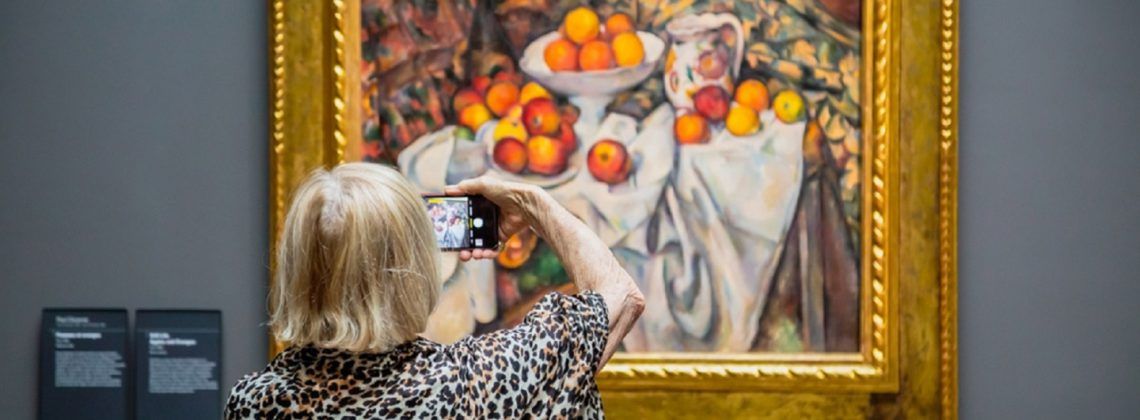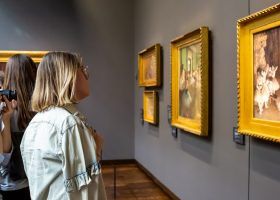Old train station or art gallery? Why not both? The Musée d’Orsay might be smaller than the Louvre, but it’s home to the most famous Impressionist artwork on the planet. Seriously, if you’re into art, this place is a goldmine. In this guide, I’ll fill you in on when to visit, how to snag tickets, the best tours to take, how much time to budget, the museum’s fascinating history, and more.
Pro Tip: Planning what to do on your trip to Paris? Bookmark this post in your browser so you can easily circle back to it before your visit to Musée d’Orsay. Check out our guide to Paris for more planning resources, our best Musée d’Orsay tours for a memorable trip, and the top things to do while in Paris.
Visiting the Musée d’Orsay: What We’ll Cover
Is Musee d Orsay better than the Louvre? I’m not even going to try to answer that because the two museums are so unique. The Musée d’Orsay is the heart of Impressionism and Paris’s second-largest museum (after the Louvre). Musée d’Orsay artworks include masterpieces from legends like Renoir, Manet, Van Gogh, and Monet. But it’s not just the art that’s captivating—the museum itself has a rich history and stands as an impressive monument.
In this guide on how to visit the Musée d’Orsay, I’ll cover everything you need to know to make the most of your experience: from the best times to go and ticket info to tours and highlights you won’t want to miss.
- Opening hours and tickets
- How much time to budget for your visit
- How to get there
- What to see
- Guided tour options
- Musée d’Orsay facts and history
- Places to eat inside and nearby
Musée d’Orsay Tickets And Hours
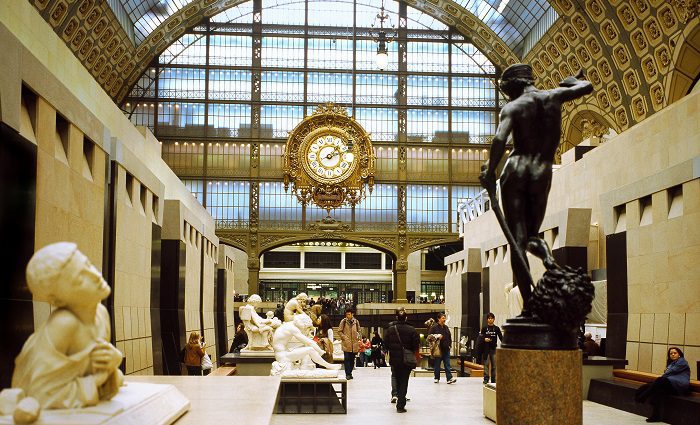
What is the best day of the week to visit the Musee d Orsay? Before you plan anything else, you need to know the Musée d’Orsay opening hours. The museum is open most days of the year from 9:30 am to 6 pm (last admission at 5 pm), except on Mondays when it is closed.
The museum also has a late opening on Thursdays where the museum stays open until 9:45 pm (last admission at 9 pm). Keep in mind that the Musée d’Orsay is closed on May 1 and December 25.
Musée d’Orsay Hours:
- Tuesday to Sunday from 9:30 am to 6 pm (last admission at 5 pm); Closed on Mondays
- Thursdays the museum stays open until 9:45pm
Pro Tip: The museum will be most crowded on Tuesdays and Sundays, so avoid these two days if possible. If you must go on these two days, then I recommend going around lunchtime (12 pm) to avoid the majority of the crowds.
Musée d’Orsay Tickets:
Do you need to book Musee d’Orsay in advance? Yes. We highly recommend purchasing your ticket in advance online. Currently, the museum averages the waiting time at the main entrance for visitors without tickets at around 50 minutes. It could be much longer in the summer months.
- Adult ticket: €16 (online), €14 (at the museum)
- Late opening rate: €12 (online), €10 (at the museum) for Thursdays from 6 pm
- Reduced price: €13 (online), €11 (at the museum) for adults accompanying someone under 18 years old)
- Free: anyone under 18 years old or under 26 years old if an EU resident
Not ready to book a tour? Check out our best Paris tours to take and why.
Musée d’Orsay Guided Tour Options
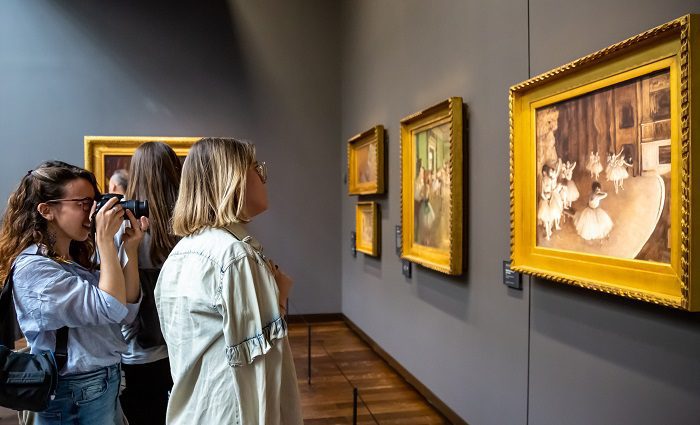
The museum does offer an audioguide in multiple languages for €5 that you can get at the front desk. If you want to maximize your experience, book a Musée d’Orsay tour to take the guesswork out of visiting and dive straight into the art and history with a passionate guide.
As a tour operator, we’re a bit biased about taking tours but we do what we do because we know how much value it brings to the experience of seeing great art and monuments. With a passionate local tour guide and skip-the-line tickets, you’ll experience the best of the museum within a manageable 2 hours. Taking a guided tour makes visiting the museum fun, interesting, and easy.
Not ready to book a tour? Check out the Top Things To See in Musée d’Orsay.
How Much Time Do You Need to Visit Musee d’Orsay?
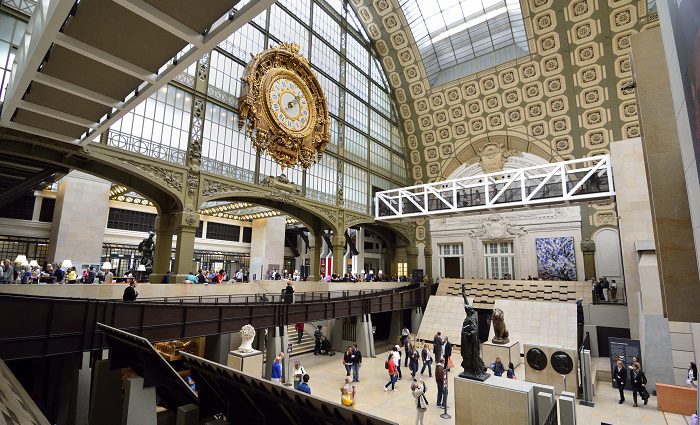
Short Answer: 2 hours
Like any museum, the amount of time you really need is a personal choice with the most important factor being how much you like the work. The museum is quite big, so my recommendation would be a two-hour visit. More than two hours without a break and you might go into art overload.
The Musée d’Orsay houses artwork on three different floors, so I’ll go through each one of them and explain what you will see, so you can decide for yourself which floors you want to dedicate the most time to.
Ground floor
In the right-hand side galleries, you’ll find artists such as Ingres, Delacroix, Moreau, and the early works of Edgar Degas, who would later become an important figure in impressionist painting.
In the left-hand side galleries, you’ll find artwork based on naturalism, realism, and pre-impressionism. Artists in this gallery include Courbet, Corot, Millet, and Manet. The masterpieces you’ll see are Millet’s The Angelus (1857-1859) and Manet’s infamous Le dejeuner sur l’herbe (Lunch on the Grass), which depicts a nude woman picnicking with two clothed men.
First floor or middle level
The main artists on this level are non-French artists such as Klimt and Munch. As for French artists on this level, you can see works by Maurice Denis, Ker-Xavier Roussel, and Pierre Bonnard. This level holds an important collection of pastels, decorative objects, and late 19th-century paintings.
Third floor
Major artists you can find here are Paul Gaugin, Georges Seurat, Paul Signac, and Henri de Toulouse-Lautrec. As you enter this floor, you’ll notice the experimentation of new methods, which will eventually lead to impressionism. There is a small gallery dedicated to small format painting.
Fourth floor
I would say that this is the floor with the most famous paintings and probably the reason why most people come to visit this museum. The artists on this floor are the kings of Impressionism as we know it today: Edgar Degas, Claude Monet, Pierre-Auguste Renoir, Alfred Sisley, Camille Pissarro, and Gustave Caillebotte.
There are entire galleries dedicated to Monet and Renoir after 1880. On the same floor, there’s the Gachet Collection where you will find the amazing paintings of Van Gogh and Paul Cezanne. You’ll also find sculptures here by Edgar Degas.
Fifth floor
This last floor, if you have any energy left, is dedicated to sculpture from the 19th century and, of course, an entire wing has been dedicated to France’s most illustrious sculptor, Auguste Rodin.
Not ready to book a tour? See if Paris tours are worth it.
How To Get To the Musée D’Orsay
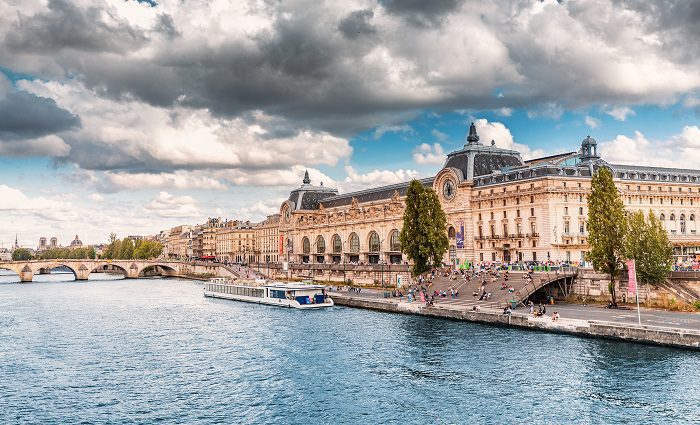
The Musée d’Orsay is easily accessible on foot, by metro, or by bus. The museum is a 12-minute walk from the Louvre Museum—it’s literally right in front of the Louvre on the other side of the river. You can easily walk there.
You can also get there by metro. Take the RER Line C and get off at stop Musée d’Orsay or Metro Line 12 getting off at stop Solferino. Alternatively, you can catch any of the following buses, which all have stops by the Musée d’Orsay: 63, 68, 69, 73, 83, 84, 87, 94.
Musée d’Orsay is handicap accessible with all floors accessible via lifts or ramps. Wheelchairs and folding seats are available on deposit of an identity document at the cloakroom.
Address: 1 Rue de la Légion d’Honneur
What To See at Musée d’Orsay
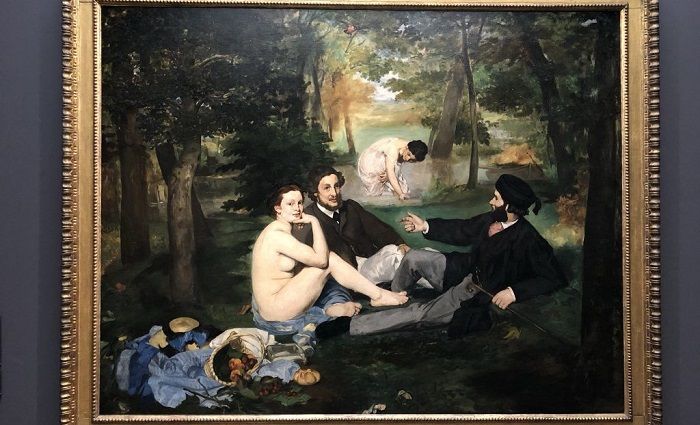
Paris’s second-largest museum has a lot to see and some important works of art at that. Here are the 10 must-see works. Be sure to check out our article on the top 10 things to see in the Musée d’Orsay for more in-depth descriptions, locations, and photos of each of the listed artworks.
- Card Players by Cezanne
- Bal Moulin Galette by Renoir
- Luncheon Grass by Manet
- Starry Night by Van Gogh
- Self Portrait by Van Gogh
- Arearea by Gauguin
- Floor scrapers by Caillebotte
- Camille sur son lit de mort by Monet
- Poppy Field by Monet
- Women Ironing by Edgar Degas
Our Best Guided Tours of Paris

Likely to Sell out
Palace of Versailles and Gardens Tour from Paris
Navigating transportation, dealing with tickets, and waiting in long lines can ruin your day at Versailles. Our half-day small group tour eliminates the hassle entirely. With roundtrip transport from Paris, skip-the-line access, and a friendly guide, you’ll effortlessly explore the palace, discover its highlights, and enjoy free time in the gardens. After your guided experience ends, you’re free to stay in the gardens, visit Trianon and take the train back to Paris at your convenience.
See Prices

Top Selling
Le Marais Paris Food Tour with Authentic Sit-Down Dinner
With local spots tucked away and confusing menus, most visitors end up overpaying at tourist-trap cafés instead of finding the authentic spots. Our local, friendly guide leads you through Le Marais to five real local businesses for eight tastings and four French drinks, including oysters, Boeuf Bourguignon, falafel, and sweet crêpes. Walk historic streets, hear food stories, and savor Paris like an insider.
Not ready to book a tour? Check out our best Paris tours to take and why.
Facts and History of the Musée d’Orsay
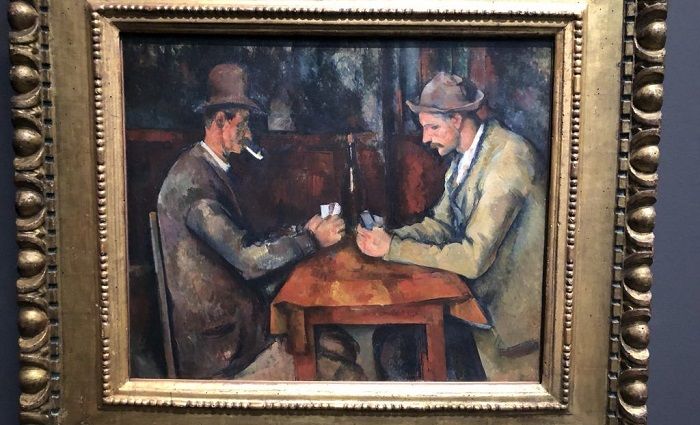
- The building was originally a train station, the Gare d’Orsay.
- The main hall of the museum is an amazing 452 feet long (138 meters), 131 feet wide (40 meters), and 104 feet high (32 meters).
- 12,000 tons of metal was used to construct the building—that’s almost twice as much as the Eiffel Tower.
- 35,000 square meters of glass was used—the equivalent of about three Manhattan City blocks.
- The museum has the largest collection of impressionist and post-impressionist artwork.
- The three massive clocks in the museum are the originals from the train station.
- The museum had 3.6 million visitors in 2019.
- 1 million cubic meters of air is treated each hour for air conditioning.
History of the Musée d’Orsay
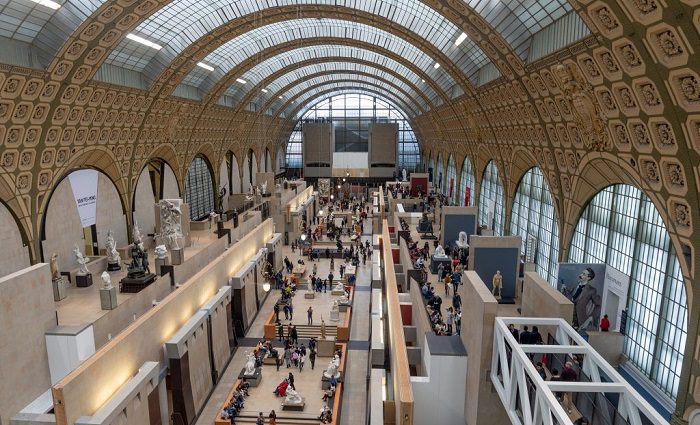
The Train Station
The current Musée d’Orsay was previously a train station (called a Gare in French) and hotel, which was built in just 2 years and inaugurated in time for the Worlds Fair on July 14th, 1900. In order to ensure that such a massive structure didn’t look out of place, the particular stone chosen came from the Charente and Poitou regions.
The amenities were extremely modern for the time with ramps and lifts for luggage, elevators for the passengers, a reception area on the ground floor, electric traction, and 16 underground rail tracks.
It immediately became the head of the Southwestern French railroad network. The hotel became a popular venue for various gatherings of associations and political parties.
During the War
By 1939, the Gare d’Orsay was limited to traveling to the suburbs of Paris since its platforms were too short for the more modern and longer trains that were being built.
As World War II began, the train station was used as a mailing center to send packages to prisoners of war and was also the final destination point for those prisoners returning after the liberation of the war.
The hotel finally closed its doors on January 1st, 1973. Among the many occasions and events that took place at the hotel, one of the most famous was when General De Gaulle announced his return to power in the ballroom.
The Birth of a Museum
At this point, the train station needed a new reason for being. There were plans to demolish the area and build a huge hotel on the spot, but the Direction des Musées de France had decided that the area would be better suited to a museum that could represent artwork from the second half of the 19th century and was made official on October 20th, 1977.
On December 1st, 1986 then-president François Mitterand inaugurated the museum and it opened its doors to the public on December 9th of the same year. The collections were brought in from three main sources:
- Louvre Museum: The works of artists born after 1820 or coming to prominence during the Second Republic.
- Musée du Jeu de Paume: Since 1947, this museum had been dedicated to the works of Impressionism.
- National Museum of Modern Art: When moving over to the Centre Georges Pompidou, it only kept artwork from artists born after 1870.
Places To Eat Inside and Nearby
Inside
Café Campana: €€ | Beautiful Setting—The Musée d’Orsay has one restaurant inside the museum itself, called Café Campana. The cafe, designed by the Brazilian Campana brothers, is a tribute to Art Nouveau and is meant to transport you into a dreamlike aquatic environment.
The menu is casual with a cafeteria-style vibe, so you’ll get your meal fast. The café prides itself on seasonal, fresh ingredients and also has large salads and ice cream. It’s a lovely place to take a break and refuel before continuing your museum visit.
Address: Musée d’Orsay
Nearby
The Musée d’Orsay is conveniently located near St. Germain des Prés, which is a very happening district and full of great restaurants and cafés.
Address: St. Germain des Prés
Check out this article for a full list of The Best Restaurants near the Musée d’Orsay.
Visiting the Musée d’Orsay is a must for anyone who appreciates art and culture. It’s not just about the breathtaking collection of Impressionist masterpieces; it’s also about the unique atmosphere of the museum, housed in a stunning former train station that adds a layer of charm to your experience. From the vibrant colors of Monet to the emotional depth of Van Gogh, each piece tells a story that resonates long after you’ve left. Plus, with fewer crowds than other major attractions, you can really immerse yourself in the art and history. So if you’re in Paris, don’t miss the chance to explore this captivating gem—you’ll walk away inspired and enriched.
Not ready to book a tour? See if Paris tours are worth it.

Where To Stay in Paris
With a city as magnificent as Paris, it can be hard to find the perfect hotel at the perfect price. Explore the best hotels and places to stay in these incredible neighborhoods in Paris.
